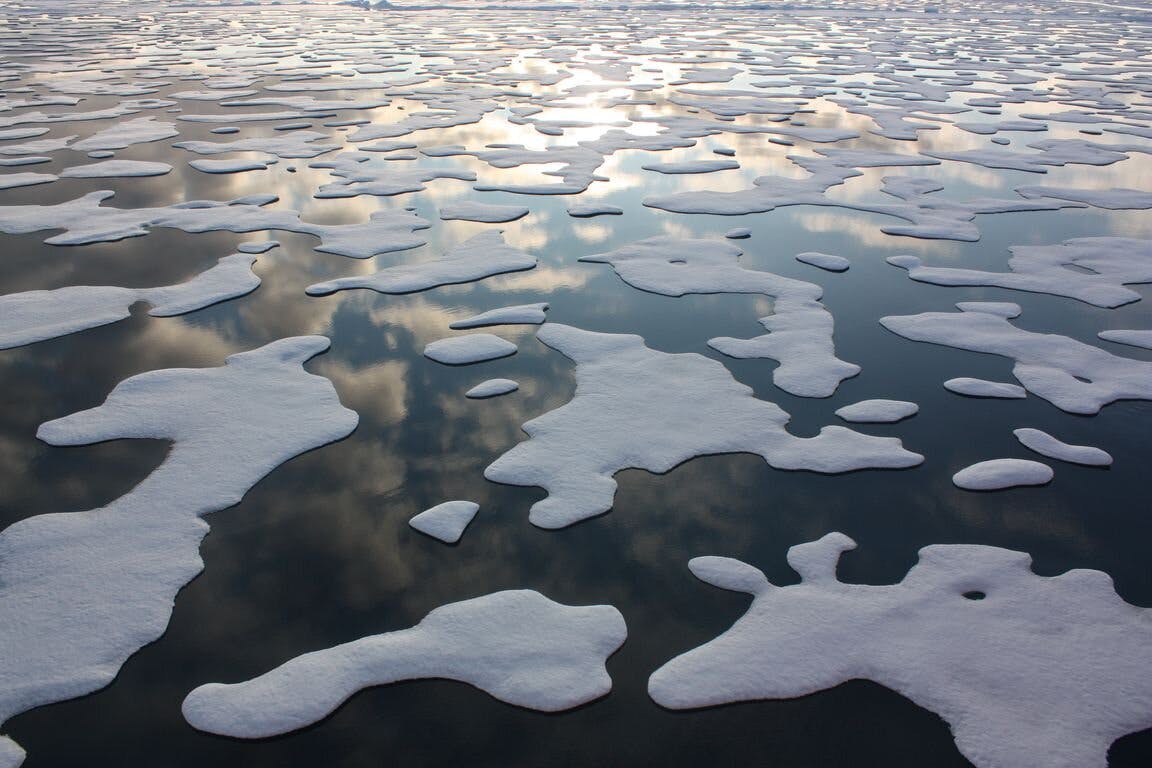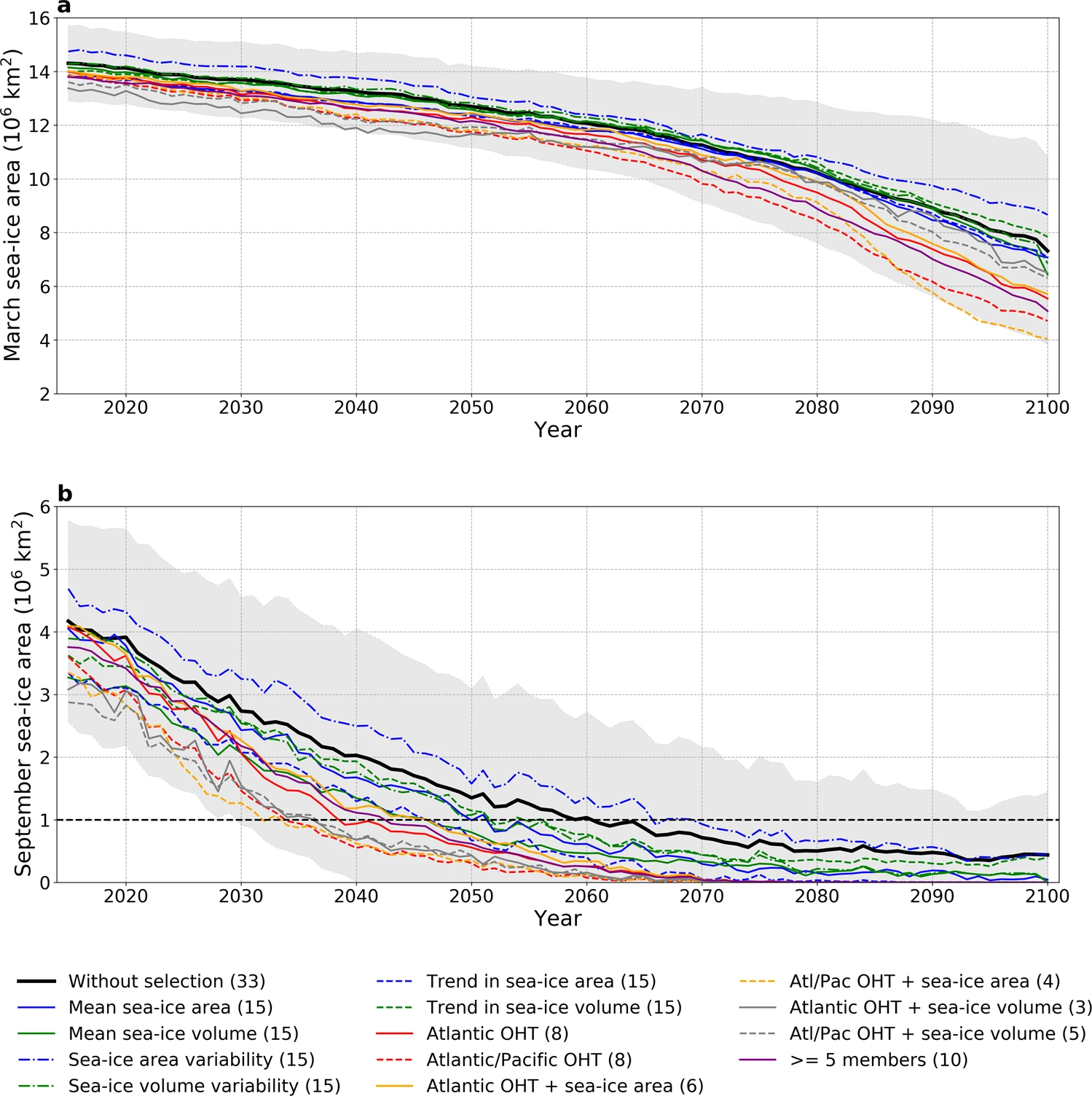
The criteria for resolving yes is that the Arctic must be fully ice-free at any point in time between now and the start of 2050. The Arctic does not need to be fully gone by the year 2050, it just needs to be ice-free at a moment in time.
Whether the Arctic is fully ice-free will be based on news articles from reputable sources. If there's any controversy, I will discuss about it with Manifold users in the comments.
As a last resort of resolution criteria, this question will resolve Yes when the Arctic ice coverage (at a threshold 15% ice density) falls below 100,000 km squared, as reported in numbers from http://nsidc.org/arcticseaicenews/charctic-interactive-sea-ice-graph/
The Arctic has less ice cover in summer than in winter, so it is plausible that in summer, the Arctic will be fully ice-free, but in winter, it will reappear. This type of scenario will resolve as Yes.
Relevant info:
https://english.elpais.com/science-tech/2023-06-07/the-arctic-is-set-to-completely-melt-for-the-first-time-within-two-decades.html
A study supported by observations from NASA and ESA satellites and a sophisticated climate model predicts that the first ice-free September will arrive between 2030 and 2050.
https://phys.org/news/2019-11-arctic-ocean-ice-free-year.html
According to a new study by UCLA climate scientists, human-caused climate change is on track to make the Arctic Ocean functionally ice-free for part of each year starting sometime between 2044 and 2067.
People are also trading
I think people are underrating the importance of the 100k km^2 threshold vs. the usual 1M km^2 threshold, as per Christopher Randles's comment below. The key search term seems to be "last ice area". My general impression from some searching is that models expect it to take maybe a few additional decades for ice to disappear there after the Arctic is mostly ice-free by the 1M km^2 standard, though there's uncertainty and a YES resolution isn't out of the question.
@StevenK Perhaps, and I might be the the worse of the lot. There is still a lot of uncertainty with such far off predictions though...
I don't remember what materials or how much effort I referenced in my original bets, but it was probably along the lines of this one:
https://www.nature.com/articles/s43247-021-00214-7
It would be fair to bet NO depending on your assumptions given an interpretation of the above paper alone though.
I choose a high sensitivity (betting most of the climate member models in will continue to be too conservative with regards to change in general and that sensitivity will be shown to be on the high end of CMIP predictions).
For even members that are selected to be better mapping current conditions relevant to the question (Atl+Pac OHT+sea ice area below (yellow dotted)), the mean itself I think might also be a conservative point estimate for this question given the interannual variability (perhaps in the early 2040s even).
Much more speculatively, solely on my part: (honestly just a guess, so I will leave it as a spoiler): that there are still yet more unknowns/feedbacks left that bias it to a greater sensitivity and greater acceleration towards a sea-ice free summer (this has been a general trend recently in climate predictions being too conservative) that make me want to drop 5-10 years off 20+ year climate predictions in general (i.e. taking the 2060 mean point below and deducting 10 years is already close to 100-250k km and this is small enough that any of these years before or after could have enough variability to reach this threshold for the question).

The general rationale for such member selection (from above):
"The stronger reductions in sea-ice area and volume over the twenty-first century partly stem from the fact that some of the selected models have a larger sensitivity to anthropogenic global warming than the non-selected models. Also, the smaller present-day sea-ice area in the selected models is due to the fact that the multi-model mean without selection overestimates the observed sea-ice area (Fig. 3a, b); thus, the selection of models closer to observations reduces this overestimation, explaining the smaller present-day sea-ice area"
You may update the title :)
Added 4k subsidy
It is interesting.
Pretty much all the models seem to show that after a period of rapid decline, the rate of decline then becomes slower and slower. This is exactly what we have seen since a rapid decline circa 2000-2012.
This could well be an indicator that the rapid decline is just easy areas melting out and that from now on it gets harder and harder to melt additional areas. This can also be explained in a few ways:
In terms of ice movements: The areas that have retreated are along the Russian side. These areas generally have ice moving away from the coast due to the general movements of the Beaufort Gyre and the Transarctic drift. Because the ice is moving away from the coast gaps tend to open up and this allows extra solar energy to be absorbed by the darker water which assists melting. Contrast near Greenland and Canadian Arctic Archipelago the movements tend to be toward the coast so any gaps that form from melting and cracking tend to close up again.
Thick multiyear ice. Pre 2000 thick multiyear ice used to survive the trip around the Beaufort Gyre. This is fresher water as salt is removed by melting and freezing processes so it is harder to melt the ice and with more thickness there is also more ice to melt. As retreat worked further in from Chukchi, less of the thick multiyear ice made it round the Beaufort gyre so in subsequent years the multiyear ice became, in general, younger so thinner and saltier and less and less made it around the gyre. This made it easier to melt a bit more of the multiyear ice each year in the Chukchi and East Siberian sea until very little now makes it around the gyre.
So the rapid decline near the Russian coast became a vicious circle of enhancing effects during ~2000-2012. Now the ice melts out every year in these areas these effects have ceased and the remaining ice gets harder and harder to melt out.
When you understand how these different areas have behaved differently it becomes obvious that the rate of decline is likely to slow down as the models show and can be seen since ~2012.
The scientists often refer to less than 1 million km^2 extent as ice free or practically ice free. By 2050 we could well be down to that sort of level. However here you have set the level at 100,000 km^2 so I think there is a good chance that at least that amount will remain at the summer minimum until 2050.
Not sure if you wanted such comments but perhaps this might be helpful. Good luck with your debate.
@bohaska I would change the title to include that then. As written I take the Arctic fully melting to include Greenland.